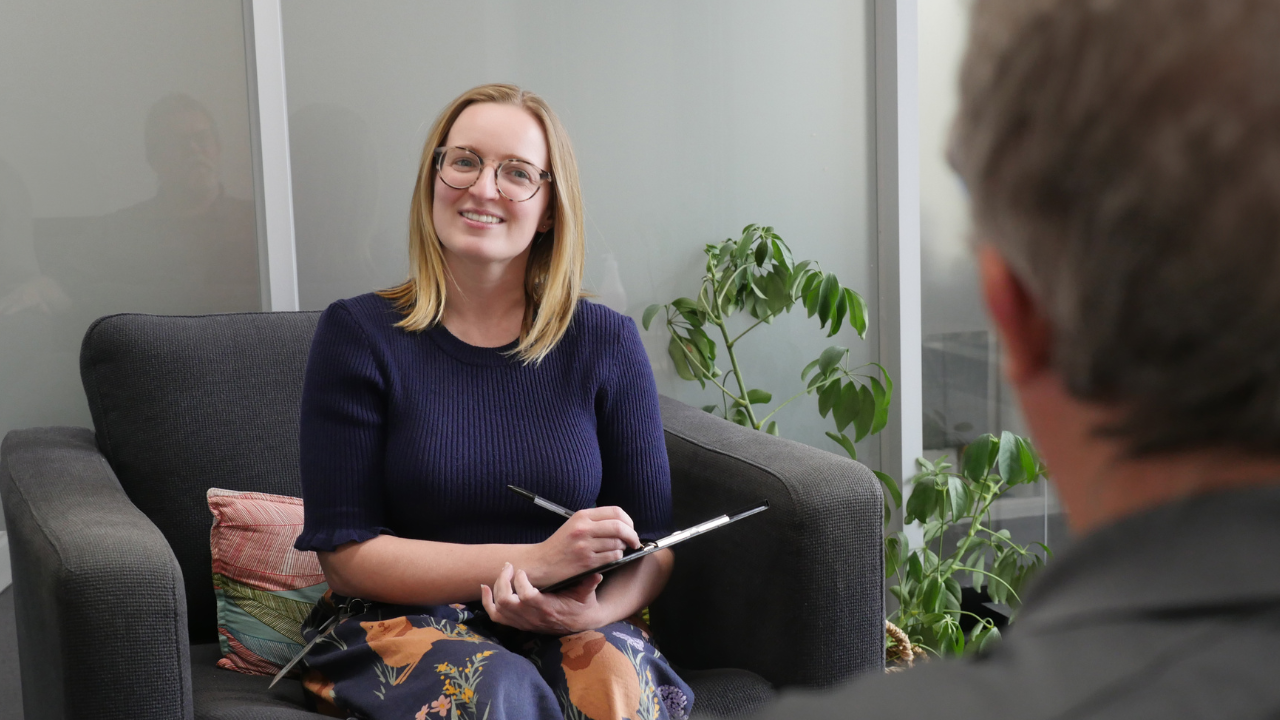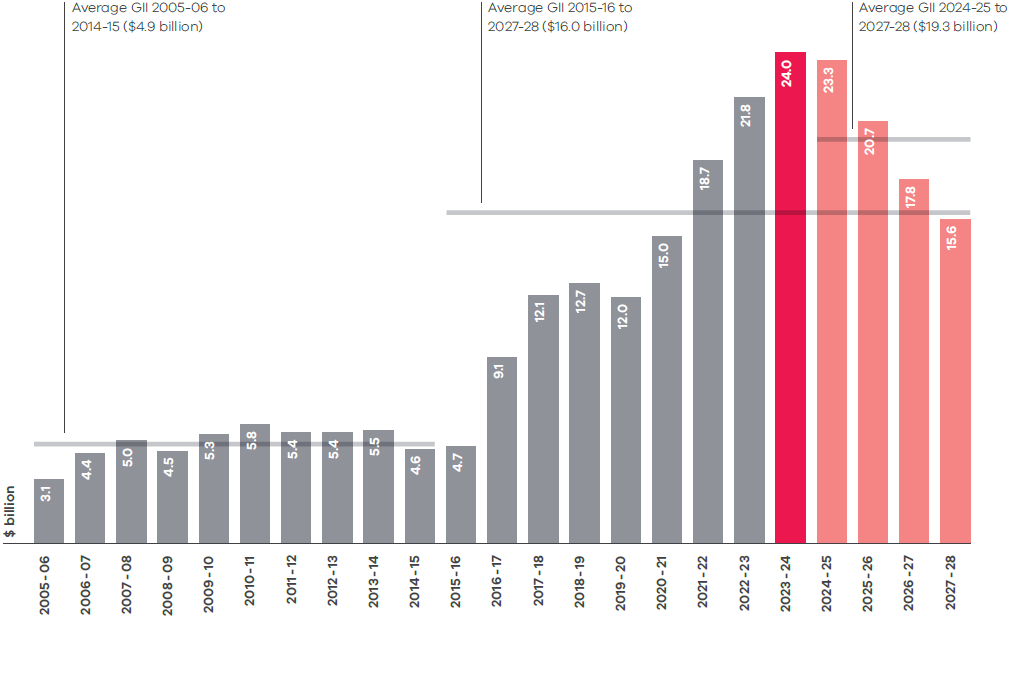
As a state, we need to consider how we balance these competing challenges. And now is the time to recalibrate.
The International Monetary Fund, in its recent report on Australia, says now is the time for governments to implement infrastructure projects at a more measured pace, given supply constraints.
By moderating the pace of some of our big projects and reforms, we give Victoria’s workforce time to build up and skill up, we allow supply chains to catch up – and we give industry time to take a breath.
Importantly, this will also free up tradies for residential construction, supporting the Victorian Government’s agenda to build more homes for Victorians.
This Budget progressively returns the capital program towards pre-pandemic levels to proactively manage workforce constraints and inflation.
As the chart below shows, we are moderating investment over the forward years – while continuing our strong record of delivering the infrastructure and services Victorians need.
Right now, we’ve got state‑transforming transport projects underway, including Metro Tunnel, West Gate Tunnel and North East Link.
At the same time, we have a huge amount of funding tied up with the Melbourne Airport Rail project. We need to be realistic about the project and its timeline.
The Commonwealth Government has only recently appointed an independent mediator, and the Airport has not indicated it is prepared to drop its demands for compensation and an underground station.
We’ve made the sensible decision to acknowledge that the project is now at least four years delayed. This will allow us to crack on with delivering other projects.
We’re also addressing COVID-19 era programs that are no longer needed – or have led to inefficiency behind the scenes. These include:
- Reducing the Government’s advertising spend. During the pandemic, government advertising expenditure increased to keep Victorians safe with health information and to rebuild our economy. With both of these aims complete, we’ll return advertising spending back to pre-pandemic levels.
- Concluding the Sick Pay Guarantee pilot. Created during the pandemic to protect Victorians and give casual and contract workers sick pay, the Sick Pay Guarantee will conclude on 30 June 2024.
- Reducing the size of office space across the Victorian Government – reflecting the changed nature of work.
Breakthrough Victoria was established in the Victorian Budget 2020/21 – aimed at helping our state’s economy recover, turn our world-leading research into world leading companies and grow local jobs in the wake of the pandemic.
Breakthrough Victoria has deployed more than $330 million, including investments in 24 companies.
With Victoria’s economic growth outlook leading the nation, and more Victorians in work than ever before, this Budget reprofiles funding for Breakthrough Victoria.
That means funding will be reduced by an average of $90 million a year over the next four years, and the fund’s investment profile extended from 10 to 15 years, giving Breakthrough Victoria more time to review and be selective about quality investments.
By identifying COVID-19 era spending that is no longer essential, we have been able to divert that funding to the frontline – investing in the services and support that Victorians rely on and delivering cost of living help where it's needed most.
This Government is also pursuing some of the biggest social reforms not only in Victoria’s history – but Australia’s.
It’s why, just as we carefully balance and support our infrastructure workforce, we need to do the same with our early education and care sector.
Once fully implemented, our Best Start, Best Life reforms will require more than 11,000 extra educators and teachers. Already we’ve invested $370 million to recruit hundreds of early childhood workers – from scholarships to overseas recruitment.
But as we continue to experience sustained low unemployment, we need to be pragmatic about the size and scale of this once-in-a-generation reform – requiring us to more than double the workforce on 2019 numbers.
With this Budget, we’re taking a more gradual rollout of these reforms. While a majority of regional and rural locations will commence on schedule, with a staged increase in hours, we’re extending the full rollout of Pre-Prep from 2032 to 2036. We’ll also deliver the first 30 of our government-owned and operated early learning and childcare centres by 2028, with an additional five opening every year until 2032.
This more gradual approach will ease pressure on the workforce pipeline and provide the sector space to grow the strong and stable workforce this nation-leading reform needs.
We’re taking a similar approach with the rollout of our Mental Health and Wellbeing Locals.
Victoria is leading the nation in mental health reform. With more than $6 billion invested since 2018, we are rebuilding our mental health system from the ground up. This year’s Budget continues Victoria’s record support – delivering an increase in mental health investment.
But this reform doesn’t just require significant investment – it also requires a significant workforce expansion.
In order to deliver this reform, Victoria will require an additional 2,500 mental health workers – from psychologists to psychiatrists, mental health nurses to support workers.
We simply can’t deliver these reforms – or the first-rate care Victorians deserve – without the workforce behind us.
To give us the time to ensure we have the people and skills we need, this Budget pursues a more gradual approach to the rollout of our Mental Health and Wellbeing Locals. That gives us the opportunity to train and recruit the required workforce – and it also makes sure we’re properly learning from the rollout of the first two tranches.
An evaluation of the existing rollout and a plan for the next phase of the work will be done prior to the next budget.
Building the workforce we need for the future
This Government has invested – and continues to invest – to grow our skilled workforce:
- Investing $555 million to support TAFEs, deliver Free TAFE and attract more Victorians to take up the skills we need for our growing state.
- Providing $370 million to attract, train and recruit more early childhood educators and teachers.
- Delivering $38 million to strengthen vocational education in our schools.
- Establishing clean energy worker training centres for hydrogen and wind, and the State Electricity Commission (SEC) Centre of Training Excellence to help train the workforce that will support Victoria’s transition to cleaner, cheaper energy.
- And with this Budget, $16 million to deliver a new mental health graduate program in our Local Services, helping to build the pipeline of trained professionals we need.
Updated


